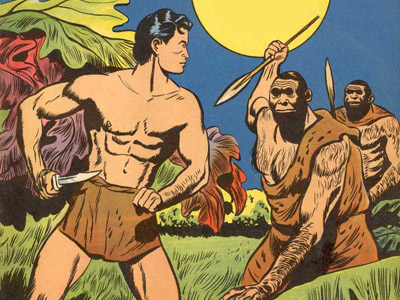
It's not finished yet but I'm glad to report Jesse Hamm has been setting up a website devoted to the late comic book artist, Jesse Marsh. Marsh, who is best known for his 15-year stint drawing Tarzan comics, was one of the most controversial illustrators ever in the field. Artists as acclaimed as Russ Manning and Alex Toth found his work brilliant and said they learned from him. Readers must have liked him too, as the comics he drew seemed to sell better because of him. Other professionals and some students of the form either consider his work insignificant or less than competent. A number of devout fans of Edgar Rice Burroughs particularly loathed the non-E.R.B. interpretation of the character that Gaylord DuBois wrote and Marsh drew, and organized a letter-writing campaign to get Marsh replaced with Manning. The Marsh output they hated has probably not received enough attention from comic art scholars for there to be any clear consensus, but the comment has been made that his simple, primal style made adventure stories seem uncommonly accessible to young readers.
Marsh was a former Disney storyman (he got screen credit on Make Mine Music, Melody Time and a few others) who began freelancing for Western Publishing Company around 1946. He decided he liked drawing comic books better than writing gags for Walt, and the editors at Western gave him all he could handle. For a long time, he was their "star" adventure artist on the Dell Comics they produced, working on westerns, Tarzan, movie adaptations…any number of comics and occasionally on their line of books for children. As far as I know, he never worked for any other company.
He was incredibly fast, sometimes doing all the art and lettering for an issue over a long weekend. In fact, he believed that good comic art should be done in a bold, spontaneous manner so if he found himself spending a lot of time on a page, he'd tear it up and start over. He cared very little about anatomical correctness in his figures or proper perspective. According to his friend Russ Manning, Marsh had but two goals in his artwork. One was to tell the story with maximum clarity. The other was to spot his large black areas in a manner that formed a balanced design on the page. Often, he would start a new page by laying in a large abstract design that would fill the entire drawing area. Then he would divide the page (and that design) into six panels and, working with very little pencilling and a thick, ink-loaded brush, he'd attempt to incorporate one sixth of the design into the composition of each panel. Sounds odd, but it seemed to work.
At least for some people. The editors at Western loved both the man and his work, which was fortunate for Marsh. In the early sixties, execs with the Edgar Rice Burroughs estate began demanding an artist with a more sophisticated style…someone who would draw a slicker, more muscular Tarzan like the one seen in the newspaper strips. The editors replied, in effect, "We like what Marsh is doing and the book is selling well. If you want to take the rights away from us, fine…but we will not replace Jesse." Knowing that Marsh was in poor health and could not last forever, the Burroughs folks elected to wait him out on the condition that Manning would succeed him. Marsh retired in '65 and died the following year. His last year or two of Tarzan comics must have been excrutiating for the E.R.B. company and fans since failing eyesight caused the artist to continually simplify and exaggerate further. In other words, he intensified everything his detractors disliked about his work. I suspect history will eventually side with the Western editors in praising him but for that to happen, the comic art community will have to pay a little more attention to his artistry. That's why I'm glad we have this new website to begin to correct that oversight.